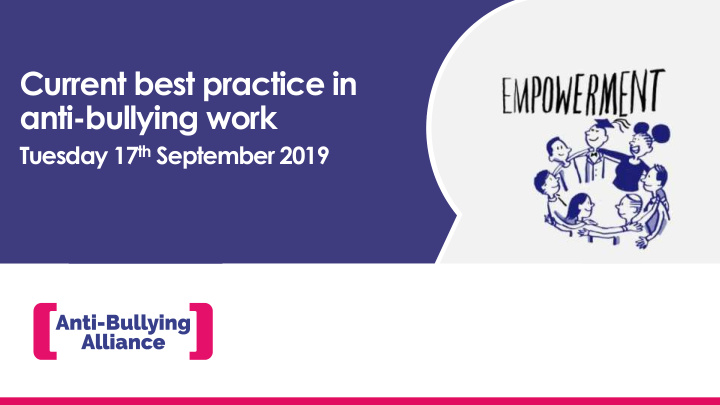



Current best practice in anti-bullying work Tuesday 17 th September 2019
True or false? 40%
True or false?
True or false?
What is bullying?
What is bullying? The ABA (Anti-Bullying Alliance) defines bullying as: The repetitive, intentional hurting of one person or group by another person or group, where the relationship involves an imbalance of power. Bullying can be physical, verbal or psychological. It can happen face-to-face or online.
Is it bullying? Hurtful Repetitive Intentional Power imbalance
Preventing bullying
Preventing bullying High discipline and Improving school Anti-bullying respectful / caring climate *** policies school staff *** Social skills for Communication Work with young people (inc. with parents bystanders *** empathy) *** Training for staff, Assertiveness Meaningful roles for break time staff and training young people transport staff Reducing societal inequality (government)
Reporting and recording bullying
Reporting: what do young people say? There’s a lack of Often we are not There’s no clarity over understanding about what believed; the situation bullying is and isn’t – among is judged too quickly who to report to / how pupils, parents and and/or not taken to report school staff seriously
Reporting/recording: some recommendations • A shared definition of bullying displayed throughout the school and known by all staff, students and parents . • A variety of reporting methods that account for communication needs and allow young people to feel safe and secure in reporting. • Ensure that students understand that it is their right to feel safe and secure in their environment.
Responding To bullying
Responding Effective, informed and well planned responses are critical.
Responding to bullying Negative sanctions Restorative approaches Support group method (no blame)
Effective response – what children tell us they want To be involved in the solution – we For schools to For the bullying to are often anxious educate children stop. This is more that teachers will and young important than who rush to punish and people about is right or wrong that this will cause why bullying hurts more bullying.
A model of response Secure the safety of those involved STEP 1 • Safeguarding? • Report and record STEP 3 • Assure CYP (and parents) that you have taken their report seriously and immediate action will be taken STEP 2 STEP 2 Stopping the behaviour reoccurring • Use group roles to identify those involved STEP 1 • Make it clear that the behaviour needs to stop • Work with the group in the most effective way to stop the behaviour reoccurring Whole school learning STEP 3 • Reflect back as a school. What has this incident taught us? e.g. do you have an issue with language in school? Is there a need for staff training? Refresh policies? • Who needs to be informed of the change? Parents?
What can we provide? Anti-Bullying All Together Free CPD online Week 2019: Programme training Change Starts With Us Free to all schools in England 7 modules including Monday 11 th – Friday 15 th to take part cyberbullying November
Thank you for participating. www.anti-bullyingalliance.org.uk
Recommend
More recommend